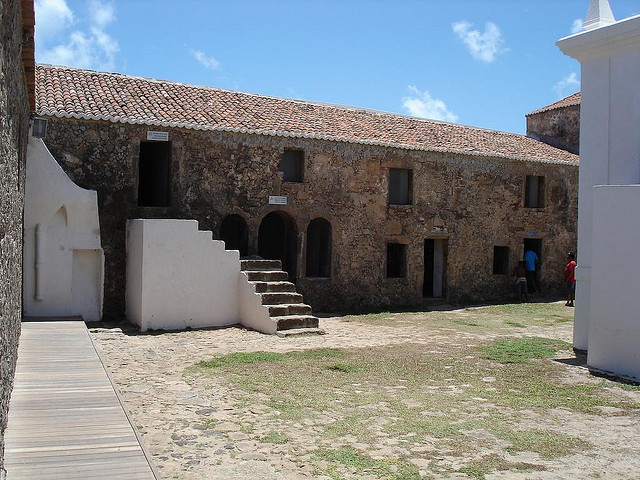
Inside the walls of Forte dos Reis Magos. Photo © Guilherme Morais, licensed Creative Commons Attribution.
What few historical sights Natal possesses are located in the bairros of Ribeira and Cidade Alta, which fan out from the Forte dos Reis Magos (Av. Presidente Café Filho, tel. 84/3202-9006, 8 a.m.–4:30 p.m. daily, R$3). The most impressive of the all-too-few vestiges of the past is the star-shaped fort itself. Poised majestically along a reef, it is separated from the tip of the city by a sandbar. Construction on the fort began on January 6, 1598—the feast day of the Reis Magos (Three Kings). Inside, the most important historical artifact on display is the Marco de Touros, a limestone cross engraved with the herald of the Portuguese king. The cross, originally planted in the village of São Miguel do Gostoso in 1501, symbolizes the first claim to Portuguese territory in Brazil. In 1962 it was transferred to the fort because villagers—who had come to view it as a miraculous object—had taken to chipping pieces off to make curative teas for ailing family members. The fort itself was built using a mixture of stone, sand, whale oil, and oyster shells. From its ramparts, the views of the city and coastline are quite stupendous.A couple of leisurely hours is enough to explore the rest of what’s left of historic Centro. The heart of the colonial city is Praça André de Albuquerque. It is flanked on one side by the 17th-century Igreja Matriz de Nossa Senhora da Apresentação. A block away lies the pretty baroque Igreja de Santo Antônio (Rua Santo Antônio 698, tel. 84/3211-9068, 6 a.m.–5:30 p.m. Mon.–Fri., 8–11 a.m. Sat.–Sun.), which houses a small sacred arts museum. Surrounding the Praça Sete de Setembro is the Palácio Potengi (tel. 84/3211-7056, 8:30 a.m.–5:30 p.m. Tues.–Sun., free), the Victorian-style former governor’s palace, which displays a collection of period furniture along with temporary exhibits of works by local artists. Also worth a glimpse is the city’s premier theater, the grandly neo-classical Teatro Alberto Maranhão (Praça Augusto Severo, tel. 84/3222-3669, 9 a.m.–5 p.m. Mon.–Fri.), located a few blocks west of the Palácio Potengi.
A trio of modest museums are worth popping into. The Museu Café Filho (Rua da Conceição 161, tel. 84/3232-9724, Ribeira, 8 a.m.–5 p.m. Mon.–Fri., 8 a.m.–6 p.m. Sat., 8 a.m.–2 p.m. Sun., R$1) makes a big deal about the fact that its former inhabitant, João Fernandes Campos Café Filho, was once president of Brazil. In truth, the inept Natalense only lasted a year in power. He stepped in after Getúlio Vargas shot himself in 1954, and quickly stepped down again in early 1956, citing poor health. It is worth taking a quick spin through his elegant mansion. The Museu Câmara Cascudo (Av. Hermes da Fonseca 1398, Tirol, tel. 84/3342-4911, 8–11 a.m. and 2–5 p.m. Mon.–Fri., 8–10 a.m. Sat., R$3) provides an informative hands-on overview of Rio Grande do Norte’s social and natural history. Fun gimmicks include stepping into a typical fisherman’s shack and investigating a recreated salt mine. Occupying the second floor of a renovated old bus station, the Museu de Cultura Popular (Praça Augusto Severo, Ribeira, tel. 84/3232-8149, 9 a.m.–4 p.m. Mon.–Fri., 10 a.m.–4 p.m. Sat., free) offers permanent and temporary exhibits that testify to the richness of Rio Grande do Norte’s popular arts, both visual and musical.
Excerpted from the Third Edition of Moon Brazil.